Another Owl Tour today. The weather forecast was not ideal for owls – cold, cloudy and windy with the risk of snow showers! Thankfully, once again it was not as bad as forecast and we had a great day. We managed to find some owls and some other good birds besides.
We started with a drive round to see if we could find some Barn Owls still out hunting, but with the conditions it was perhaps no surprise to find that they had already gone in to roost. At one brief stop two Stock Dove flew past, we flushed a Little Egret from a wet meadow and listened to Greylag Geese flying inland honking. A little further along and we could see a large skein of several hundred geese flying towards us over the fields. Pink-footed Geese presumably looking for a recently harvested sugar beet field on which to feed. We pulled over and listened to them as they flew overhead, their distinctive higher pitched yelping calls very different from the Greylags we had heard earlier.
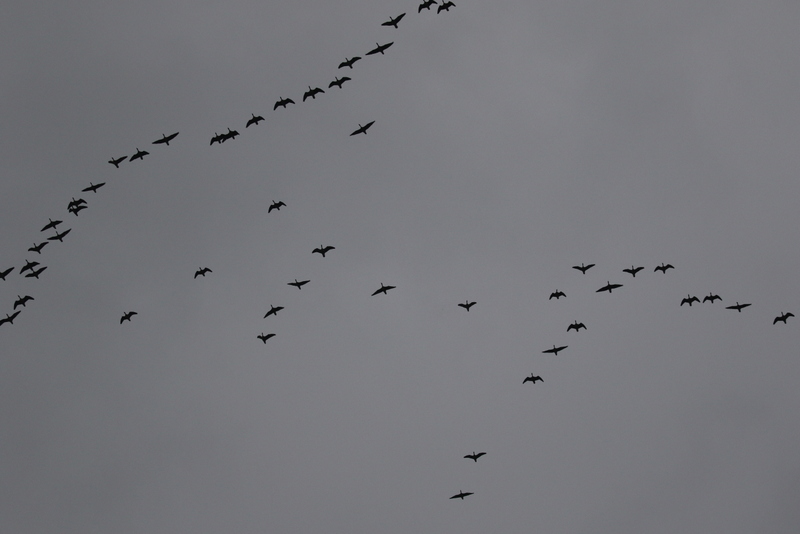 Pink-footed Geese – a large skein flew over the road calling
Pink-footed Geese – a large skein flew over the road calling
Making our way further inland, we headed for one of our regular Little Owl spots. It didn’t take long to find our first Little Owl, perched up in a sheltered spot on the roof of one of the farm buildings. It was a long way off, so we drove along the road for a slightly closer look. We could see it better from here but it was still some way away, a little ball of feathers fluffed up against the cold.
A short distance down a footpath, we made our way round to the back of some other farm buildings which are more sheltered. Sure enough, here we found another two Little Owls, a little closer still. They too were hunched up under the roof of a barn. One of them did fly out onto the roof at one point, but clearly thought better of it and headed back quickly to where it had been tucked up out of the wind.
On our way back to the car, we disturbed a Brown Hare, which ran across the path in front of us at high speed and disappeared into the trees. A stubble field nearby held a nice flock of Curlew, all but invisible until they flew round. A group of Lapwing flew inland from the direction of the coast.
Carrying on our drive westwards, we stopped briefly at another couple of sets of barns, which we know are occupied by both Little Owls and Barn Owls. Given the weather, it was perhaps not a great surprise that no owls were perched out here today. We did see some nice farmland birds on our drive. A covey of Red-legged Partridges next to the road were accompanied by a pair of Grey Partridges – always nice to see. Several Kestrels were perched on posts or wires, looking down from there for food rather than hovering this morning. And we saw several more Brown Hares, although they were mostly hunkered down in the fields.
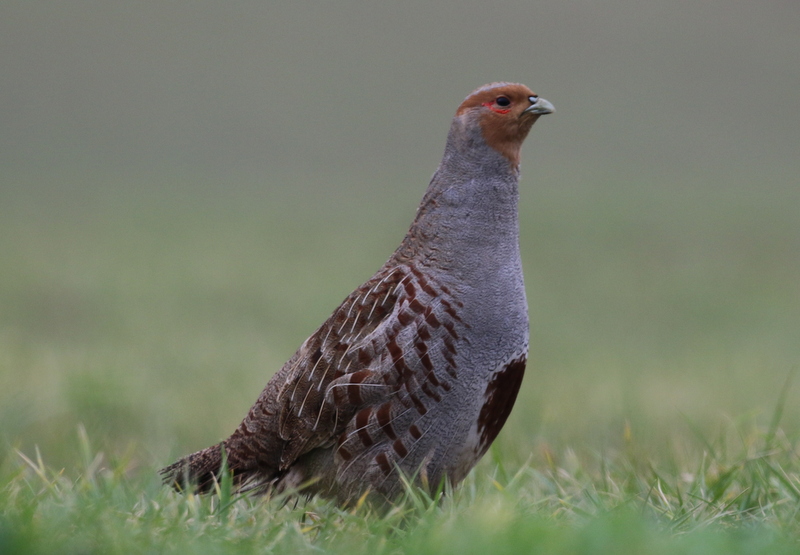 Grey Partridge – a pair were by the road with a covey of Red-legged Partridges
Grey Partridge – a pair were by the road with a covey of Red-legged Partridges
A little further on, we had hoped to catch up with a flock of geese in a recently harvested sugar beet field, where they have been feeding for the last few days. However, when we got there, we couldn’t find any sign of them. We thought they might be loafing in another field further back, so we drove round there to have a look, only to find a long line of twenty or more men with shotguns strung out across the landscape. Perhaps it was no surprise that we couldn’t find any geese today! With the shooting season for most game having closed at the beginning of this month, they were shooting Brown Hares. We could see that many of them had dead Hares hanging from their waists. Sad to see such beautiful animals like this.
With the morning getting on, we decided to head for Titchwell to do some more general birding and resume our search for owls later. As we set off from the car to head for the visitor centre, one of the group asked about the Woodcock which has been seen recently by the path here. Often it is further back in the trees out of view, but today we were lucky. Just as we were talking about it, we glanced into the bushes and there was the Woodcock less than 10 metres from the path!
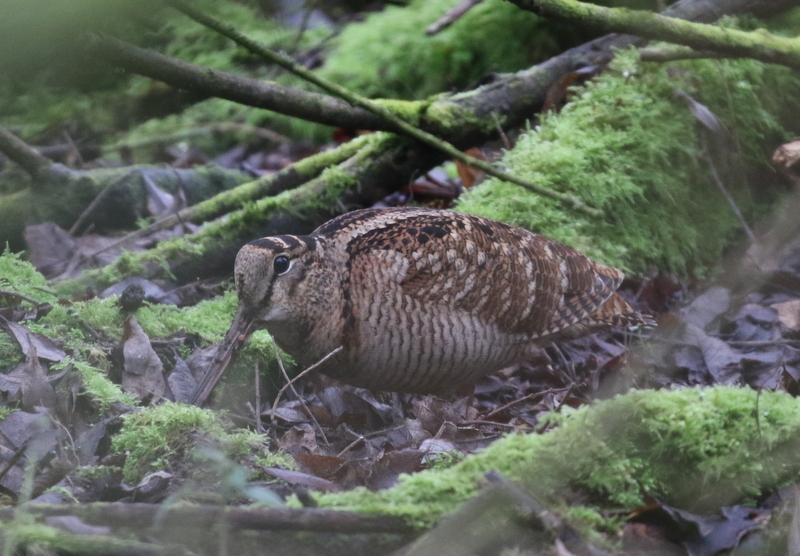 Woodcock – great views, feeding by the path at Titchwell
Woodcock – great views, feeding by the path at Titchwell
The Woodcock was feeding actively, walking about among the branches and probing its long bill into the wet leaves looking for earthworms and other invertebrates. They are surprisingly large, chunky birds, with very intricate patterning which provides great camouflage. Against the rather dark brown rotting leaves here, this Woodcock’s rusty colouration meant it rather stood out! We watched it for a while as it worked its way further back into the trees and disappeared from view. Given Woodcock are mainly nocturnal, it was great to see one so well, a rare treat.
The feeders by the Visitor Centre held a nice selection of finches, mainly Chaffinch, Goldfinch and Greenfinch. But in amongst them we managed to find a single female Brambling, which kept flying out of the bushes behind and hovering by one of the feeders, but it seemed reluctant to land. We scanned the alders for redpolls, but all we could find in the trees today were more Goldfinches and Greenfinches.
The Water Rails were more obliging. As we got out onto the main path, one was feeding in the ditch straight ahead of us. We had a great look at it as it walked around nervously out in the open, probing in the dead leaves. A little further along, a second Water Rail was in the ditch on the other side of the path briefly.
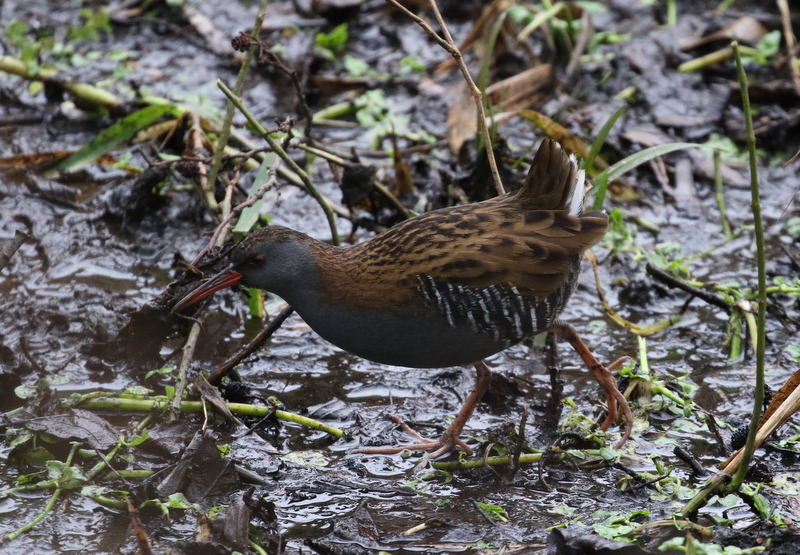 Water Rail – feeding in the ditch by the path again
Water Rail – feeding in the ditch by the path again
Out of the shelter of the trees, there was a keen cold breeze, so we made our way quickly along the path. A couple of Marsh Harriers were circling over the reedbed at the back of the still dry Thornham grazing marsh ‘pool’. The Water Pipit appeared briefly out of the ditch along one side, but flew off behind the reeds before everyone could get onto it. Otherwise, it was very quiet on here again today. The reedbed pool held a single Tufted Duck and a few Mallard.
The water level on the freshmarsh is still rather high, but has now dropped a fraction. We made our way straight round to Parrinder Hide to scan from the comparative warmth inside! There was a nice selection of winter ducks on here today, including several Pintail sleeping in front of the hide. Through the scope, we could see the drakes’ long, pin-shaped tails.
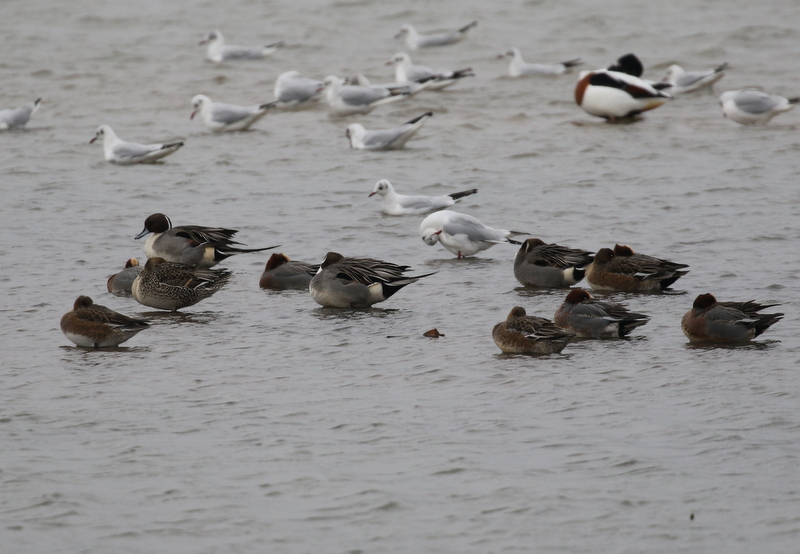 Pintail & Wigeon – sleeping on the freshmarsh
Pintail & Wigeon – sleeping on the freshmarsh
A single Bar-tailed Godwit was bathing on the edge of the mud, and then flew across to join the ducks in the shallower water and preen. A single Black-tailed Godwit dropped in nearby too, and we were able to get a good comparison looking between them and see the key differences between these rather similar species in winter plumage. A few Knot flew in too and in with them we found a single Ruff (a female, or Reeve), similar sized but longer legged and with distinctive scaly-patterned upperparts.
The thirteen over-wintering Avocet have returned to the freshmarsh, now that the water level has dropped a little. The fenced off island was covered with roosting Lapwing and in one corner were several Golden Plover which had obviously just been bathing and were now preening and flapping. While we watched, another large flock of Golden Plover flew in from the fields and dropped in to join them.
From the other side of Parrinder Hide, we had a look out across the Volunteer Marsh. There was a nice selection of waders in front of the hide here. Several dumpy grey Knot were feeding on the mud just below the windows with a few smaller and browner Dunlin nearby for comparison. A Grey Plover was hard to pick out against the mud until it moved. There were also several Curlew and Redshank.
 Knot – in grey winter plumage
Knot – in grey winter plumage
Having warmed up in the hide, we decided to make a quick dash out to the beach. On the way, we stopped briefly to admire a Black-tailed Godwit on the mud just below the path on the Volunteer Marsh and a couple of close Little Grebes on the near edge of the tidal pools.
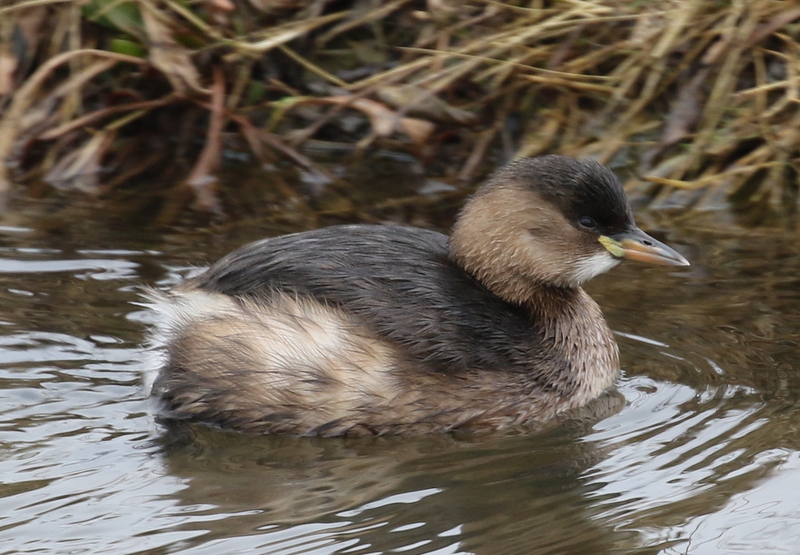 Little Grebe – on the tidal pools
Little Grebe – on the tidal pools
There was a chill in the north-easterly wind out on the beach, so we didn’t want to stay out there long. The tide was out but we had a quick look at the sea from the edge of the dunes. About 30 Velvet Scoter were diving just offshore, hunting for shellfish. We could see the twin white spots of the females, although the young males with them are now looking mostly dark headed. We could see the white in the wings, visible on the flanks of several which were holding their wings loosely and on others as they flapped. The Common Scoter were much further out, probably about 2,000 today, visible as a long black slick spread out across the water.
While we were watching the Velvet Scoter, a couple of Long-tailed Ducks appeared with them briefly. We just had time for a quick look at them through the scope, before they flew off. There were also a few Goldeneye and a pair of Red-breasted Merganser out on the sea today. Then, with the group starting to get cold, we made a quick turnaround and walked back.
After finishing lunch back at the car (the first sitting had been held in Parrinder Hide), we set off again. It was still a bit early for owls, so we had a quick look in the harbour at Thornham first. There was no sign of the Twite here today, but we did find a few waders in the channel – including Black- and Bar-tailed Godwit and Curlew. A very obliging pair of Brent Geese fed on the tiny strip of saltmarsh between the road and the boats.
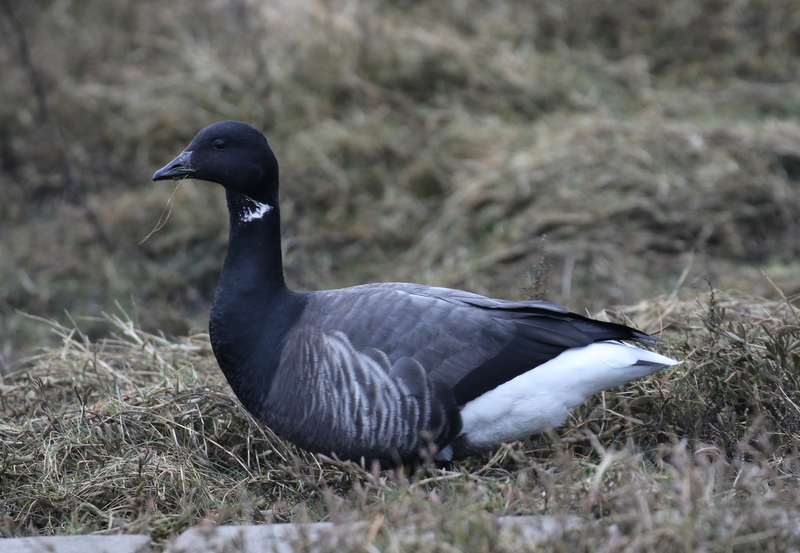 Brent Goose – one of a very obliging pair at Thornham today
Brent Goose – one of a very obliging pair at Thornham today
A quick look in at Brancaster Staithe produced a few more waders. The highlights were a few Turnstone and Oystercatcher feeding around the piles of discarded mussels. Several Goldeneye were diving down in the harbour channel. Then, with the afternoon progressing, we made our way back west to look for owls again. We stopped off at several regular Barn Owl sites on the way, but with the weather as it was it always seemed unlikely we would encounter too many out hunting before dark. We would need a bit of luck!
There were no Barn Owls out yet at Holkham either. We scanned the freshmarsh for geese too, but all was quiet here apart from a Grey Heron. There are still good numbers of White-fronted Geese here normally, but there was no sign here today. A few hundred metres further down the road we found out why – they were all in a field beside the road! We pulled up with our hazard lights on and had a look at them from the car so as not to flush them. There were more than a hundred White-fronted Geese here, we could see the white around their bills and black belly-barring on the adults, along with a few Greylags.
 White-fronted Geese – over a hundred were next to the road at Holkham
White-fronted Geese – over a hundred were next to the road at Holkham
A little further along, we found a single Egyptian Goose in the same field and at Lady Anne’s Drive we stopped to look at a small group of Pink-footed Geese out on the grass. The wind had picked up and it was quite blustery on the coast, so we decided to continue our search inland. We stopped at a set of barns where a pair of Barn Owls roost, but there was no sign of them out hunting yet today, despite it being around the time they usually emerge.
We drove on, round via several more sites where Barn Owls like to hunt. We had just checked out one grassy field, without success, and were driving away when we happened to glance over and caught a glimpse of a white shape through the trees. Reversing carefully, we pulled up in a gateway and could see it was indeed a Barn Owl on a post.
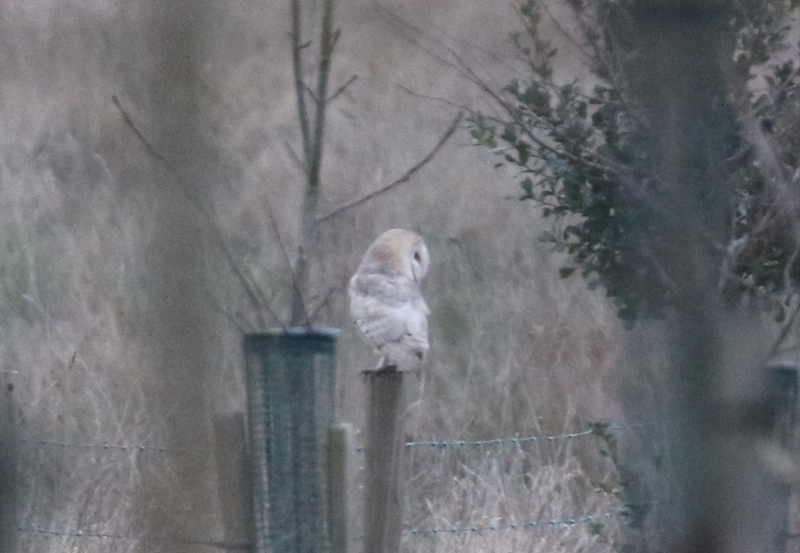 Barn Owl – on a post
Barn Owl – on a post
There was a convenient path we could walk along to overlook a rather overgrown field which was sheltered on all sides by a belt of trees. From here, we had a great view of the Barn Owl perched on a fence post. Given the wind, it was probably trying to hunt by sight, and it worked its way down along the fence line in short hops, stopping each time to scan the ground below.
Then a second Barn Owl appeared, flying over the field at the back. It landed in a tree further over. While we were watching it, the first Barn Owl then started to hunt more actively, circling round over the field, dropping down into the tall grass from time to time. It came much closer, hunting round into the corner of the field closest to us, great to watch. Eventually, it retreated to the trees where it perched and the second Barn Owl started to hunt over the grass. We watched them both for some time, leaving them only when both had disappeared into the trees to rest.
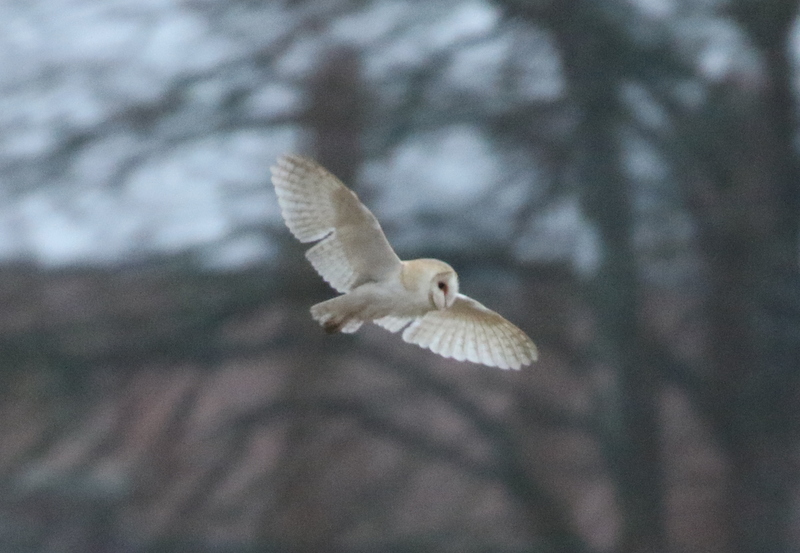 Barn Owl – eventually started hunting over the field in front of us
Barn Owl – eventually started hunting over the field in front of us
These two Barn Owls had obviously found a sheltered field to hunt, which was why they were out here today and showed no inclination to go anywhere else. Great for us. It was already getting on towards Tawny Owl time, but we had a quick swing round via some other meadows where there are often Barn Owls, without further success.
We arrived at the woods just in time. As we got out of the car, we could already hear a Tawny Owl hooting, earlier than normal tonight, possibly due to the grey and overcast skies meaning the light was fading fast. We made our way quickly down to the area where we know one of the Tawny Owls likes to roost, just in time to hear it hooting from the roost trees. At least this meant we knew roughly where it was going to emerge tonight.
After a couple more hoots, the Tawny Owl flew out of the trees and straight towards us. It normally likes to perch up further back first, but perhaps because of the wind, it came further through the trees. It landed on a perch not far from us, but was hard to see against the dark background of ivy-covered trunks. Before we could get it in the scope it took off again, possibly surprised by our presence, and disappeared back into the trees. Then it went silent.
The other Tawny Owls had stopped hooting too, and it seemed for a few minutes like that might be it for tonight. We tried a quick whistled hoot, but got no response. The trees were quiet, but for the raucous coughing of the many Pheasants going to roost in the trees. We were about to give up, but tried one more whistle. Without a sound, a large dark shape came out of the trees behind us and flew over our heads. The Tawny Owl was back!
I had disappeared back into the trees again, but after a few seconds it flew back out and landed in a tree right above us. Once again, the Tawny Owl was frustratingly hard for the group to get onto here, against the ivy in the gloom, despite the fact that it was only a few metres above us. We tried to get it in the scope, but before we could it was off again. Thankfully, this time it flew across the path and landed in a bare tree, silhouetted against the sky. Now everyone could see it. It perched there for some time hooting, before flying back through the trees towards us and landing above us again. Fantastic stuff!
 Tawny Owl – perched above our heads, hooting at dusk
Tawny Owl – perched above our heads, hooting at dusk
The Tawny Owl remained above us hooting for a couple of minutes. At one point it flew across the path, right over our heads, to a tree the other side. It was great to see it overhead, to get a real sense of its large size and broad, rounded wings. Eventually, it dropped back into the trees and was lost to view. It was getting dark as we made our way back to the car, but we still had the evocative hooting of the Tawny Owls from the trees to listen too, a great way to end another very successful Owl Tour.
















